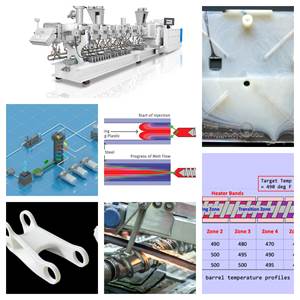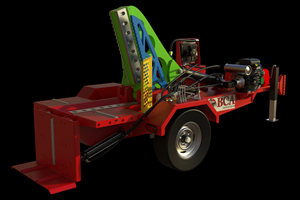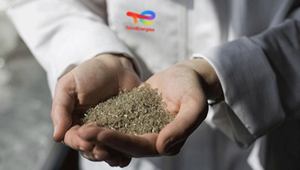What's New in Printing & Decorating
New systems to process mixed plastic waste and to upgrade it with fiberglass or wood flour were prominent at last June’s show in Chicago. Single-shaft rotary grinders made a strong showing as newer alternatives to conventional granulators and shredders.
Recycled Resin Prices Flatten Out
New systems to process mixed plastic waste and to upgrade it with fiberglass or wood flour were prominent at last June’s show in Chicago. Single-shaft rotary grinders made a strong showing as newer alternatives to conventional granulators and shredders.
Whatever your needs in printing or decorating on plastics, you probably can find some new solutions in the large crop of the new equipment and supplies introduced at the NPE 2000 show in Chicago. Among them are the latest pad printers, including novel machines that produce new cliches on the fly or combine capabilities for pad printing and laser marking or hot stamping. There are also lots of new dry-offset and silk-screen printers, presses for hot stamping and heat-transfer decorating, and plasma or corona treaters. A handful of other developments bring enhancements to laser marking, ink-jet printing, metalizing, in-mold decorating, and spray painting.
Pad printing teams up
One of the more innovative printing machines at NPE was a pad printer that incorporates a laser to engrave its own plastic-film cliches. Tampoprint’s new CTP 60/90 Computer to Press system is capable of printing one motif while simultaneously engraving a new one by means of a diode-pumped laser. You can change the motif by pushing a button. The silicone pad is cleaned by an ink-residue pick-up system. The unit’s “Digi-Press” film-cliche roll can hold up to 340 cliches, allowing it to process customized inscriptions or batches of files. All common data formats are available.
This system is also available in a CTPM 60/90 version, which offers both laser-marking and pad-printing capabilities. Also, it can use its laser to engrave metal or ceramic cliches.
Another interesting decorating system is the new Uni-Ring “multi-print” device that can integrate up to five pad-printing and/or hot-stamping modules into a multi-color decorating system. Launched by United Silicone, it boasts close-tolerance color registration and individual print-head control. It has a cycle rate of 2000/hr and optional auto-load/unload.
Pad-print modules have sealed ink cups with up to 60-mm print diam. and x-y-r print-module adjustment. The hot-stamp modules have 0.5-ton stamping force, pneumatic drive with positive stop, head-up delay, and x-y-r adjustability.
Meanwhile, the maker of another new modular pad printer says it sets new standards for flexibility and machine intelligence. The G2 MPPS base system from Printex is a platform for an array of optional user-installable “plug-and-play” indexing systems and inking kits. Users can choose single, two-color, multi-color, or transverse inking, as well as linear shuttles, rotary tables, carousel indexers, and more.
Among the key features of the core G2 is a pin-registered image-plate mounting system that accommodates up to 150-mm ink cups and their respective plate formats for one- or two-color printing. It can be switched to 100-mm cup format for one- to four-color printing. It can also be quickly removed and a transverse cup-sliding mechanism can be easily installed for wide-format printing. The pad arm features a built-in extension that can be used to speed the downstroke and eliminate pad extenders or spacer blocks when using low-profile printing pads.
The latest pad printer from Deco Technology Group is the new microPrint 5 Star from microPrint LC GmbH of Switzerland. This one- to five-color, programmable, servo-driven unit requires only one nesting fixture because it indexes the print heads instead of the parts to be printed. Standard features include PLC control with touchscreen interface. Operators can independently program pad-to-plate and pad-to-part strokes, time delays for either ink pick-up or print stroke, and multiple hits at every print station. Tape pad cleaning is also programmable. The 5 Star can run 86-mm or 120-mm closed ink cups with no tools required for changeover.
Service Tectonics unveiled the Model 625, an addition to its Pat-A-Print line of pad printers. The unit is capable of printing up to 3600 cycles/hr with steel or polymer plates. Its small footprint (8 x 15 in.) is suited to in-line production. It also boasts quick-change cliches and easy-to-use controls.
Changeovers reportedly are completed within seconds and without the need for tools on the new TPU 131 sealed-cup pad printer from Teca-Print USA. Its PLC control and pushbutton operator interface are used to set different operating modes, dwell-time adjustments, and vertical pad strokes. Up to 50 print-job settings can be stored. This single-color machine accepts cup sizes to 96 mm diam. It can be converted to two-color application in as little as two minutes.
The new Padflex 3000 servo-driven pad printer for large formats was shown by Autoroll. This is the company’s largest multi-color pad printer, capable of printing crisp, high-detail images on plastic housings and automotive parts. It can accommodate up to four 180-mm closed ink cups and can transfer images as large as 165 mm diam. The programmable servo drive reportedly can match single-color speeds of 1200 parts/hr and four-color shuttle speeds of 350 parts/hr.
The UP 300 and the UP 500 are two new series of pad printers from United Silicone. Both can utilize covered inkwells and can be changed easily to sealed ink cups for reduced set-up time. Modular design allows them to serve as a stand-alone unit or be integrated into automated systems. Printers in both series feature a DSP controller that displays machine settings and status, as well as diagnostic messages for quick troubleshooting. The UP 500 Series printers have larger printing areas. Standard cliche sizes for the UP 500 are 4 x 8 and 5 x 8 in., with a maximum ink-cup diam. of 5 in. Standard cliche sizes for UP 300 are 3 x 6 and 3 x 8 in., with a maximum ink cup diam. of 3 in.
Pad Print Machinery has a new rotary pad printer for up to 360° decorating of tubes or cylinders. Applications include printing numbers on refrigerator knobs or coding on continuous extrusions. The MR-100 is made by Comec in Italy. This electro-pneumatic, single-color unit prints 5000-9000 parts/min, depending on application and degree of automation. Its controller stores parts count and operating rate for each job.
Offset & screen printers
Three uv-cure, multicolor dry-offset printing systems from Apex Machine made their debut at NPE. The C-42 is a fully automatic system for marking synthetic wine corks at rates of over 120 corks/min. It consists of a vibratory feeder, pretreating section, four-color print station, uv dryer, and siliconizing station.
The new C-700 is a system for printing needle cartridges and plastic tubes at over 500 parts/min. It incorporates a bulk loader, pretreating section, three-color printer, uv dryer, and discharge station.
Meanwhile, the CA-80 is a plastic hanger printer that can operate at over 250 parts/min using water-based inks. It incorporates a feeder, three-color printer, uv dryer, and upstacker. It can also be retrofitted to print directly onto plastic hanger clips, which are used to identify clothing sizes.
The new CNC-K-908 from Kase Equipment is described as a versatile sidewall printer for high-quality line, halftone, or process work. This nine-color machine can print up to 600 cups/min. Automatic job memory for quick set-up and repeatability is said to allow up to 10 changeovers per day. It has computer-controlled registration and ink color.
Kase also offers the new CNC 8000 eight-color pail printer, a dry-offset machine said to reproduce line, halftone, or process printing with the utmost clarity and sharpness. The electronic motion-control system allows touchscreen adjustment of plate cylinder, ink, and print tower. This unit can print on any shape pail up to 16 x 16 in.
News in Surface Treating
Plasmatech, Inc. introduced a rotary drum option on its V55-GKM microwave plasma-treating system to permit high-volume treatment of bulk parts. Rotation of the drum within the process chamber ensures uniform treatment of thousands of parts. The drum is easily removed so that the 16 x 14 x 18 in. chamber can be used to process larger parts.
Lectro Engineering launched the LT 2000 3-D plasma treater. It is 75% smaller than previous systems, as well as being faster, and costing only a fraction as much, the company says.
Corotec has added two new corona-treating systems to its Uni-Dyne line. One is a self-contained, wide-web convertible corona treater, said to allow installation in just a fraction of the time required by other systems. The other is a corona unit designed specifically for blown-film applications. It has an easy-access open-frame design, two-side treating capability, swing-out electrode assemblies, and attractive pricing (starting at $16,000).
Pillar Technologies featured the new “universal Split Box” corona treater for blown film lines. Its easy-threading, drop-though design opens up horizontally so the operator can thread substrates directly into the system. Other features are said to include easy gap adjustment, stainless-steel segmented electrode, and easy roll removal.
Softal featured its new MultiDune line of corona treaters, which have a built-in timer and one or two treating heads, each with 800-W output. Special versions with up to 10 treating heads are also available.
Polytype America introduced the compact BDM-611/920 dry-offset cup printer with eight or nine colors. It boasts a low-maintenance color-head drive and synchronized servo drives for the print section and mandrel turret. Speeds are up to 600 parts/min and cup-size changes can be made within 30 min.
Van Dam showed its new Model 520 six-color dry-offset cup printer with production speeds of up to 450 parts/min. It has a servo-driven feeder, easily accessible enclosure, and quick-change mandrel set. Other key features are the shuttered uv, on-mandrel curing system with immediate restart capability, and an exact-counting restacker. The printer handles cups of 2 to 7 in. diam. and 1.125 to 7 in. high. Controls have a menu-driven, icon-based interface.
Another new dry-offset printer that reportedly slashes set-up time, boosts production rates, and requires little training was featured by Miner Technologies. The Accuprint machine is designed for cups, cosmetic tubes, and pails of 3 to 7 in. diam. Print height is approximately 8 in. depending on the type of container. Speeds go up to 700 parts/min. The servo-driven machine is said to permit changeovers in 20 to 30 min instead of the typical 2 to 4 hr.
NPE news in screen printing includes the Jumbo C39 with uv dryer from H.L. Newman Equipment. It can print on a wide range of bottles, pails, drums, jars, and tubes. This semi-automatic machine can print up to a 39-in. image on cylindrical, tapered, oval, and flat surfaces.
A new high-speed (90 parts/min) screen printer was introduced by Dubuit of America. The new SPACE machine prints on bottles for cosmetics and cleaning products. Two special advantages are claimed over competitive machines. First, its “preprint” module ensures all detection functions, pretreatment, and positioning are accurately operating prior to making the decoration. It also incorporates a new uv dryer that is said to use innovative technology for curing large bottles at high output rates. The print head features a fixed axle that is said to allow for quick changeovers.
News in heat transfer
At NPE, Acromark launched its Model 996 for decorating cosmetic tubes, pen barrels, pencils, markers, overcaps, and medical syringes at up to 100 parts/min. It can decorate up to 360° with hot-stamp foils or preprinted heat transfers on parts from 0.25 to 1.25 in. diam.
A new press for hot stamping and heat-transfer decorating on a wide range of part sizes was featured at NPE by United Silicone. Model US 25M has the company’s Web-Trak to accurately place heat-transfer decals. Stamping pressure is generated by a cam-amplified pneumatic cylinder. The cam-follower system is said to provide a fast advance to the part, slow die-to-part contact, instantaneous force generation, and fast head retraction.
Hastings Manufacturing introduced touchscreen controls for its entire line of hot-stamp and heat-transfer presses. These controls allow operators to store set-up parameters for fast start-ups.
The new HPRO series of programmable roll-on heat-transfer machines was launched by Cassco Machines. They feature non-contact infrared temperature sensors and standard roller widths of 6, 8, and 12 in. Optional configurations include ballscrew-driven heads for solid-color or heat-transfer applications, stationary heads for decorating water bottles and other round items, or continuous roll-on versions for extrusion lines and long flat parts.
Also new from Cassco is the Hi-Cam Series of high-tonnage, high-speed hot-stampers, which utilize a special sinusoidal cam system that’s said to provide a rapid, high-pressure stroke with remarkably low air consumption. Hi-Cam produces 5 to 20 tons of force from ordinary shop air without the restrictions of air/oil systems or the unevenness of toggle presses. This energy-saving device reportedly provides uniform, high pressure only at the end of the stroke and automatically compensates for part-thickness variations.
NPE also displayed new foils and decals to go with all the updated hardware. For cosmetic packages, Maple Roll Leaf launched a completely new line of metallic foils formulated specifically for vertical and peripheral stamping onto SAN, PP, PVC, and other “difficult” substrates. The foils are said to be resistant to abrasion, chemicals, and tapes.
Electrocal showed its new line of decals simulating stainless steel, as well as a new line for major appliances. The latter include manifold graphics and background graphics for free-standing gas and electric ranges, backguard and control-panel decals for washers and dryers, and lid instruction decals.
New heat transfers from Si-Cal use low-melting inks that are said to prevent heat discoloration (“ghosting”) of PS and ABS substrates.
Laser marking and more
A series of new YAG laser-marking systems for coding of several lines of text was introduced by Matthews International. The company also showed its new S.C.I. F.I. 3200 drop-on-demand ink-jet printer for small-character marking.
Vacuum Platers, Inc. introduced its newly patented Form/Met concept for using metalized, thermoformed shapes into plastic housings to provide low-cost EMI and ESD shielding.
A relatively new spray-painting robot, model P-145, was shown by Fanuc Robotics North America. This six-axis, electric servo-driven robot has integral paint-delivery pumps and threads the hoses through the inside of the arm and hollow wrist. It has a large work envelope: 97.5° rotation to either side, horizontal reach range of 60 in., and vertical range of 127.5 in. A brand-new enhancement is software that can track parts on a rotating wheel while spraying.
And the insert-molding method of in-mold decorating now can provide a “soft-touch” finish, thanks to a new formable paint system supplied on sheet stock by Avery Dennison. Unlike tactile paints, the Soft-Touch Formable Tactile Finish can be made in a variety of patterns (e.g., leathers, geometrics, wovens) in addition to solid colors. These finishes can be supplied on 0.20-in. laminated rollstock or preformed shells for injection molding. Thicker sheet of 0.060 to 0.400 in. can be supplied for thermoforming finished parts.
New modular G2 MPPS pad printer from Printex switches quickly from single- to multi-color printing.
Novel CTP 60/90 system from Tampoprint combines pad printing with a laser that engraves new film cliches. A different version of this modular machine can perform both laser marking and pad printing.
New C-42 four-color, dry-offset printing system from Apex Machine is designed for decorating synthetic wine corks at up to 120 corks/min.
Miner Technologies’ new Accuprint dry-offset printer is said to slash set-up time by nearly half and print on cups, tubes, and pails at up to 700 impressions/min.
Related Content
OMV Technologies Gets New CEO
Kooper brings 33 years of experience in the industrial and consumer packaging industries to OMV--the closed-loop, turnkey, inline extrusion, thermoforming and tooling systems manufacturer.
Read MorePlastics Technology’s Most-Viewed Articles from 2022
Tips, new technologies, resin pricing, best practices and more piqued reader interest at Plastics Technology in 2022.
Read MorePortable Alligator Shear for Size Reduction of Oversized Plastic Scrap
BCA Industries’ PGS100 hydraulic shear can quickly cut oversized plastic items into smaller pieces for easier shredding.
Read MoreS&B Selected as Contractor for New Hope Energy Advanced Plastics Recycling Unit
New Hope Energy and Total Energies collaboration for an advanced plastics recycling unit gains momentum.
Read MoreRead Next
Understanding Melting in Single-Screw Extruders
You can better visualize the melting process by “flipping” the observation point so that the barrel appears to be turning clockwise around a stationary screw.
Read MoreAdvanced Recycling: Beyond Pyrolysis
Consumer-product brand owners increasingly see advanced chemical recycling as a necessary complement to mechanical recycling if they are to meet ambitious goals for a circular economy in the next decade. Dozens of technology providers are developing new technologies to overcome the limitations of existing pyrolysis methods and to commercialize various alternative approaches to chemical recycling of plastics.
Read More















.png;maxWidth=300;quality=90)












